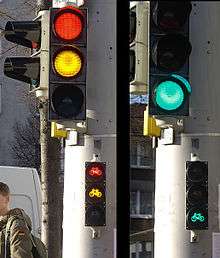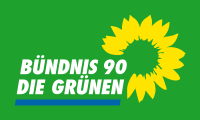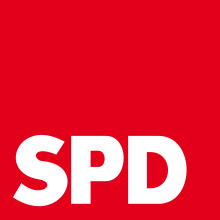Traffic light coalition
Traffic light coalition (direct translation of German: Ampelkoalition) is a term originating in German politics where it describes a coalition government of the Social Democratic Party of Germany (SPD), the Free Democratic Party (FDP), and the Greens. It arises from the fact that the parties' traditional colours, respectively red, yellow, and green, resemble the normal colour sequence of a traffic light (Ampel). It has subsequently been used to describe similar coalitions between social democrats, liberals, and greens in other countries.

History
At a state level, there have been traffic light coalitions in Brandenburg between 1990 and 1994 and in Bremen between 1991 and 1995. Negotiations to form such a coalition upon the 2001 Berlin state election were not successful, likewise, preliminary talks after the 2010 North Rhine-Westphalia state election led to no result. Recently, a traffic light coalition was formed upon the 2016 Rhineland-Palatinate state election.
 |
At a federal level, however, to date no government has been formed on this basis. Historically, there have been 'red-green' coalitions in the Bundestag between the SPD and the Greens, and social-liberal coalitions between the SPD and the FDP. However, whilst there may be common ground in terms of social progressivism between the three parties, the FDP's economic liberalism and long association at the federal level with the conservative Christian Democratic Union (CDU) make such a coalition problematic at present and the former FDP chairman Guido Westerwelle had specifically ruled out this option for the 2009 federal election.[1]
The term became more widely used outside Germany when the inconclusive 2005 federal election led to its use in the international media. Other designations included "Africa" or "Senegal coalition" (coined by Green politician Jürgen Trittin). The term Jamaica coalition—sometimes called "black traffic light" (Schwarze Ampel)—was formed in a similar way, describing a hypothetical coalition between the CDU, FDP and Greens.
In Schleswig-Holstein a "Danish traffic light" (Dänen-Ampel) was formed after the 2012 state election by the SPD, Greens and the South Schleswig Voter Federation, a regionalist minor party representing the Danish and Frisian minority in the state. Upon the 2016 Saxony-Anhalt state election, an "Afghanistan or Kenya coalition" between the CDU, SPD and Greens was formed.
Traffic light coalitions in other countries
Austria
In 1990s' Austria, the term Ampelkoalition has been borrowed from Germany to describe a theoretical coalition of the Social Democratic Party of Austria (SPÖ), the Liberal Forum (LiF) and The Greens. However, as at this time the Liberal Forum's party colour was light blue, this is a reference to the political similarity between this coalition and a German traffic light coalition rather than to the party's actual symbolic colours. After the Liberal Forum lost its parliamentary representation in the 1999 Austrian elections such a coalition remained highly theoretical, though later its party colour was yellow. In 2014 it merged into NEOS – The New Austria, whose party colour is pink, however.
Belgium
The Verhofstadt I Government of Belgium, headed by Prime Minister Guy Verhofstadt from 1999 to 2003, comprised liberals (the Flemish Liberals and Democrats and French-speaking Liberal Reformist Party), socialists (the Flemish Socialist Party and the French-speaking Socialist Party), and greens (the Flemish Agalev and the French-speaking Ecolo). However, as the political colours of the liberal parties were blue instead of yellow, it was known as the "purple-green" coalition.
Luxembourg
Following the 2013 general election in Luxembourg, negotiations started with the aim of forming a three-party coalition government comprising the Luxembourg Socialist Workers' Party (LSAP), the Democratic Party (DP) and The Greens in order to oust the Christian Social People's Party (CSV) of the incumbent Prime Minister Jean-Claude Juncker. This variant on the traffic light coalition is known as a "Gambia coalition" (German: Gambia-Koalition; Luxembourgish: Gambia(-)Koalitioun, Gambiakoalitioun), as the party colours match the flag of the Gambia,[2][3] and Luxembourg's liberal party (DP) uses blue as its party colour rather than yellow.
United Kingdom
In the United Kingdom the term has been used to describe a coalition between the Labour Party, the Liberal Democrats and the Green Party of England and Wales, notably that which formerly ran the City of Lancaster district council.[4] In Scotland, a similar coalition in the Scottish Parliament involving the Scottish Labour and Scottish Liberal Democrat parties with the Scottish Green Party was mooted following the 2003 Scottish Parliament election.[5] In that year Labour and the Liberal Democrats continued their coalition with a slender majority, and it was again the stated position of the Scottish Greens to aim for such a coalition in 2007, despite possible tension between the unionist Labour and the Liberal Democrats and the pro independence Scottish Greens. However, Green support collapsed in the 2007 Scottish Parliament election rendering the Greens non-viable as a coalition partner, although they supported Alex Salmond's election as First Minister.
Sweden
After the 2018 Swedish election the parliament was hung. After months of negotiations a traffic-light deal was set up. With the Social democrats and Greens in government and the two liberal parties giving the government confidence and supply. The left party also gave reluctant and passive support to the government despite it being outside the deal between the liberals, social democrats and greens.
See also
- Grand coalition
- Social-liberal coalition
- Jamaica coalition
- Red-green alliance
References
- "SPIEGEL Interview With FDP Leader Westerwelle - SPIEGEL ONLINE". Spiegel.de. Retrieved 2012-10-29.
- "Three-way "Gambia Coalition": a first for Luxembourg". luxtimes.lu.
- "Juncker sidelined as Luxembourg's royal palace steps in - DW - 25.10.2013". DW.COM.
- Glover, Julian (10 September 2005). "Delegates try to shake off image as single-issue party". The Guardian. London. Retrieved 25 May 2010.
- "Palgrave Macmillan - Contemporary British Politics 4th Edition". Palgrave.com. 2003-05-03. Retrieved 2012-10-29.
